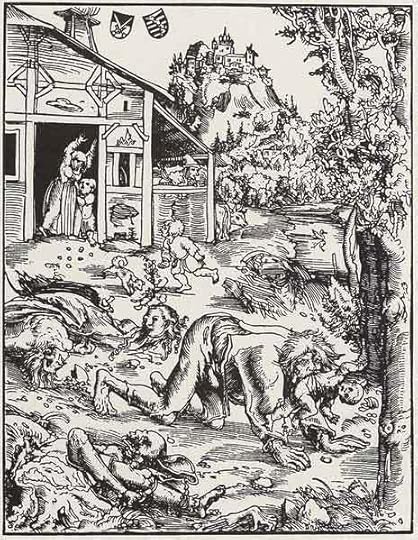Reliquary Tuesday 2: The Belt of Peter Strumpp
Information about this week's dark relic comes straight from historical documents originating from 16th century Germany. It is a bestial artifact, which can now only be known as...
The Belt of Peter Strumpp

Peter Strumpp (also known as Peter Strubb, Peter Stumpf, or by the alias Abel Griswold) was a serial killer and cannibal operating near the village of Bedburg in Northern Germany, near the major city of Cologne, which operated as a sovereign city-state of the Holy Roman Empire. Reportedly driven to evil by the age of twelve, the majority of Strumpp's crimes took place between the years of 1564 to 1589. During this time he killed at least 18 people, 14 of whom were small children. He was also an insatiable blood drinker, consuming the vital fluids of his victims, as well as livestock he stole from nearby farms. When he was finally captured for his crimes he was put to the rack, a torture which quickly forced a confession from him. He stated that he had begun practicing infernal magic, necromancy, and sorcery in his youth, even going so far as to have intercourse with succubi. At some point the young sorcerer was contacted by the Devil himself. The Devil, seeing him as a perfect agent of chaos and malice, gifted him with a belt (or in some interpretations of his legend, a girdle) made from wolf's skin. When he put the belt on he would be transformed into a hellish, black wolf, allowing him to stalk the night for victims with impunity.

art by Lucas Cranach der Ältere
The belt was supposedly light of weight and easy to hide, which some of Strumpp's accusers believed was the reason he was able to terrorize the countryside for so long. He would often travel the country roads, or even the city streets of Cologne, relentlessly stalking any target that struck his fancy. His blood lust grew so great that one evening he took his own son out into a field and told him to wait for him to return. He recounted this act to his confessors, telling them that he put on his infernal belt and slaughtered the boy, feasting upon his brains in the dead of night. News of a great black wolf spread throughout the region, and a company of hunters soon formed to take down the beast. They found Peter Strumpp in his bestial form out in a field, ravishing a young maiden whom he quickly killed. Strumpp was unaware of their presence, and after his nightly killing was done he removed the belt to return to his human form. After seeing this act of witchcraft the hunters quickly encircled him and took him captive, dragging him back to town to face trial for his crimes.

art by Lukas Mayer
The Trial of Peter Strumpp became a public spectacle, drawing most of the aristocracy of Cologne. It has gone down in history as the most famous of the "Werewolf Trials" to be held in Europe during the Medieval and Renaissance periods. Prior to his eventual sentencing, Strumpp implicated his daughter, who was reportedly a victim of his violent and perverted nature. The two were sentenced to death on October 31st, 1589. Strumpp's execution was noted as the most brutal on record in the Holy Roman Empire. He was tied to a large wheel where his flesh was peeled away by burning, iron pincers. His limbs were then broken by the blunt sides of an axe, which was done so that his villainous soul could not rise from the grave. After this, still alive and conscious, Peter Strumpp was beheaded and burned at the stake. His daughter suffered a similar fate, though it is not known if she lived through the whole process like him. After the execution, the wheel which he had been flayed on was held up by an iron post. An effigy of a wolf was placed at the center of the wheel, and on top of that the severed head of Strumpp himself, serving as a warning that the Holy Roman Empire would not tolerate more sorcerers and werewolves in their borders. The matter of Strumpp's occult crimes were described in a sixteen page pamphlet. Only two English copies of this pamphlet remain (one being held within the British Museum and the other in the Lambeth Library). Nothing is mentioned in these pamphlets about the ultimate fate of the wolf skin belt. Some believe it was taken and destroyed by the Empire, while others believe it still exists somewhere in the world...



